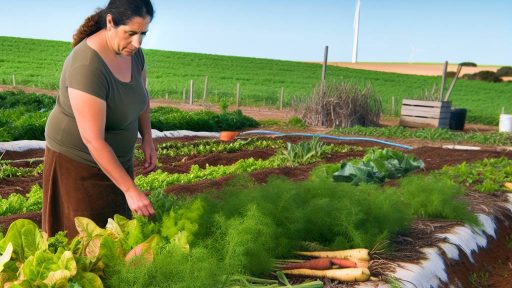Understanding the Types of Research and Development Funding Available for Farmers
Government Grants
Government grants provide essential funding for agricultural research.
They often support innovations and advancements in farming practices.
Farmers can apply for various programs at local, state, and federal levels.
Research Partnerships
Collaborating with universities can yield significant funding opportunities.
Farmers can partner with research institutions for shared projects.
This collaboration fosters knowledge exchange and resource sharing.
Private Sector Funding
Many private companies offer grants for agricultural innovations.
Business partnerships can also yield financial support for research.
Farmers should explore options provided by agricultural technology firms.
Nonprofit Organizations
Numerous nonprofits focus on sustainable agriculture funding.
These organizations often provide grants for specific research projects.
Farmers can benefit from their resources and expertise.
Crowdfunding Initiatives
Crowdfunding has emerged as a viable funding source for farmers.
Platforms allow farmers to pitch ideas and gather financial support.
This method can foster community engagement and awareness.
Transform Your Agribusiness
Unlock your farm's potential with expert advice tailored to your needs. Get actionable steps that drive real results.
Get StartedLoan Programs
Various loan programs exist to assist farmers with research initiatives.
These loans typically offer favorable terms for agricultural development.
Farmers should research available options to find the best fit.
Identifying Key Grant Opportunities and Funding Sources for Agricultural Projects
Understanding Available Grants
Farmers should seek to understand various grant options available.
Grants can support innovative agricultural practices and research.
Federal, state, and private organizations offer these funding opportunities.
Exploring Government Grants
The USDA provides numerous grants for farmers and agricultural researchers.
Programs like the Specialty Crop Block Grant Program are vital.
Additionally, local agricultural extension offices can guide funding options.
Farmers can check Grants.gov for specific applications.
Utilizing Private Funding Sources
Many nonprofits and foundations support agricultural research.
Organizations like the Walton Family Foundation often fund innovative projects.
Farmers should actively network within agricultural communities to find these opportunities.
Local chambers of commerce may have information on private funding, too.
Networking for Funding Opportunities
Networking can yield valuable insights on grant applications.
Farmers should attend industry conferences and workshops.
Connecting with fellow farmers can reveal hidden funding gems.
Social media platforms offer networking opportunities as well.
Leveraging Research Institutions
Partnering with universities can enhance funding prospects.
Many institutions have dedicated research grants for agricultural innovations.
Farmers can collaborate on projects to share knowledge and resources.
This collaboration often leads to mutual funding opportunities.
Staying Informed on Changes
Grant programs often evolve with changing agricultural needs.
Farmers must regularly review updates from funding sources.
Showcase Your Farming Business
Publish your professional farming services profile on our blog for a one-time fee of $200 and reach a dedicated audience of farmers and agribusiness owners.
Publish Your ProfileJoining mailing lists from agricultural organizations is beneficial.
Additionally, subscribing to newsletters can provide timely information.
Building Collaborations with Universities and Research Institutions for Joint Funding Applications
Identifying Potential Partners
Farmers should actively seek universities with strong agricultural programs.
Research institutions often look for practical projects in the field.
Networking at industry conferences can lead to valuable connections.
Local extension offices may have resources to facilitate introductions.
Developing Joint Research Proposals
Collaborative proposals can enhance the credibility of funding applications.
Clear communication about goals is essential for successful partnerships.
Farmers should outline their specific needs and challenges.
Institutions can bring additional expertise and resources to tackle these issues.
Leveraging Resources for Funding Opportunities
Many grants specifically encourage collaborative research efforts.
Farmers can access funding through government and private sources.
Universities often have grant writers with experience in successful applications.
Working together enhances the overall competitiveness of proposals.
Building Long-Term Relationships
Collaboration should not end with a single project.
Ongoing partnerships can lead to more funding opportunities in the future.
Regular meetings and updates can strengthen these relationships.
Farmers can leverage successes to attract new partners and funding sources.
Find Out More: Types Of Conservation Programs Available To Farmers
Utilizing Government Programs and Initiatives Designed to Support Agricultural Innovation
Understanding Available Funding Sources
Farmers can utilize various government funding sources for research and development.
These sources include grants, loans, and subsidies.
Moreover, each program targets specific agricultural innovations.
Exploring Federal Programs
Federal programs are crucial for promoting agricultural research.
The U.S. Department of Agriculture offers multiple funding opportunities.
One prominent program is the Agricultural Innovation Center Program.
This program supports business ventures that promote innovative practices.
Research Grants
Grants like the National Institute of Food and Agriculture are essential.
They aim to fund research that enhances agricultural productivity.
These grants encourage collaboration between farmers and research institutions.
Subsidies for Sustainable Practices
Sustainable Agriculture Research and Education (SARE) grants are available.
These subsidies support farmers implementing sustainable practices.
Farmers can access funds to test innovative solutions on their land.
State-Level Programs
Many states also offer funding initiatives tailored to local needs.
Programs vary by state, focusing on regional agricultural challenges.
Farmers should research specific state programs available in their area.
Collaboration with State Agencies
Partnering with state agricultural agencies can unveil funding opportunities.
These agencies possess vital knowledge of local resources.
They can guide farmers on the application processes for funding.
Networking with Agricultural Organizations
Joining agricultural organizations often opens new funding doors.
Many organizations have partnerships that facilitate access to grants.
Showcase Your Farming Business
Publish your professional farming services profile on our blog for a one-time fee of $200 and reach a dedicated audience of farmers and agribusiness owners.
Publish Your ProfileNetworking can lead to collaborative research initiatives as well.
Leveraging Local Initiatives
Local initiatives often fill funding gaps left by larger programs.
Community-based projects frequently support developing innovative practices.
Farmers should connect with local agricultural extensions.
Engaging with Nonprofit Organizations
Many nonprofits focus on supporting farmers through grants.
These organizations often have specific funding programs for innovation.
Researching available nonprofits can provide additional resources.
Applying for Competitions and Challenges
Many organizations host competitions for innovative farming solutions.
Winning such competitions can provide substantial funding and visibility.
Farmers should actively seek these opportunities to showcase their ideas.
Find Out More: Benefits of Climate-Friendly Regulations for Farmers
Creating a Strong Research Proposal
Understanding the Purpose of the Proposal
A research proposal serves as a roadmap for funding applications.
It outlines your research ideas and goals clearly.
Moreover, it showcases the significance of your project.
This helps to engage potential investors or funding organizations.
Consequently, a well-structured proposal captures attention and interest.
Defining the Research Objectives
Clearly defined objectives guide the proposal’s focus.
Your objectives should be specific and measurable.
For instance, you might aim to enhance crop yield by 20% over three years.
Furthermore, ensure that your objectives align with funding priorities.
This alignment increases the likelihood of funding approval.
Developing a Detailed Methodology
The methodology section describes how you’ll achieve your objectives.
Outline the research design, data collection methods, and analysis techniques.
Additionally, justify your chosen methods with credible references.
Include a timeline to illustrate project milestones and deadlines.
This gives funders confidence in your planning capabilities.
Incorporating a Comprehensive Budget
A transparent budget details expected costs for your research.
Break down expenses into categories like personnel, equipment, and materials.
Additionally, provide justification for each expense.
This helps demonstrate the responsible use of funds.
Overall, a well-prepared budget enhances your proposal’s credibility.
Highlighting the Project’s Impact
Explain the potential impact of your research on agriculture.
Discuss how it addresses current challenges farmers face.
Moreover, highlight benefits such as improved sustainability and productivity.
Including testimonials from industry stakeholders can strengthen your case.
Ultimately, a strong impact narrative resonates with funders.
Including an Effective Literature Review
A literature review establishes the foundation of your research.
It provides context by summarizing existing studies.
Additionally, it identifies gaps your research aims to fill.
By doing so, you enhance the relevance of your proposal.
Showcase Your Farming Business
Publish your professional farming services profile on our blog for a one-time fee of $200 and reach a dedicated audience of farmers and agribusiness owners.
Publish Your ProfileMake sure to cite reliable sources to bolster your claims.
Utilizing Clear and Concise Language
Clarity in writing enhances the proposal’s readability.
Avoid jargon or overly technical language.
Instead, use straightforward language to convey your ideas.
Furthermore, ensure each section transitions smoothly to the next.
This aids in maintaining the reader’s attention.
Reviewing and Revising the Proposal
After drafting your proposal, take time to review it thoroughly.
Check for errors in grammar, spelling, and punctuation.
Seek feedback from peers or mentors to enhance clarity.
The revision process is crucial for polishing your document.
Ultimately, a well-reviewed proposal stands out to funders.
Uncover the Details: Renewable Energy Programs Every Farmer Should Know

Leveraging Technology and Data for Competitive Grant Applications
Utilizing Precision Agriculture Tools
Precision agriculture tools enhance decision-making for farmers.
These tools analyze soil health, moisture levels, and crop health.
Farmers can use data from sensors to support grant proposals.
Including accurate data makes applications more compelling.
Moreover, precision tools can lead to smarter resource management.
Integrating Data Analytics into Farming Practices
Data analytics offers valuable insights into farming practices.
Farmers can track trends in crop yield and market demand.
Such trends provide a solid foundation for research proposals.
Furthermore, data-driven decisions can lead to improved efficiency.
Building Collaborative Networks
Collaboration fosters innovation among farmers and researchers.
Building networks can enhance access to funding opportunities.
Joining forces with agricultural institutions increases credibility.
These partnerships can include universities or research initiatives.
Additionally, collaborating can facilitate sharing of technology resources.
Emphasizing Sustainable Practices
Many funding bodies prioritize sustainable agriculture methods.
Farmers should highlight their sustainable practices in applications.
Using technology to improve sustainability boosts appeal to funders.
Thus, it is essential to showcase eco-friendly farming techniques.
Writing Compelling Grant Proposals
A well-structured grant proposal is crucial for success.
Farmers should clearly articulate project goals and methodologies.
Including measurable outcomes increases the proposal’s impact.
Furthermore, proposals should demonstrate potential benefits to the community.
Lastly, professional formatting enhances the proposal’s readability.
Delve into the Subject: Understanding Agricultural Insurance Policies for Farmers
Showcasing Successful Case Studies of Funding in Agriculture to Strengthen Applications
Understanding the Importance of Case Studies
Case studies provide real-world examples of successful funding applications.
They demonstrate the potential impact of proposed projects.
Furthermore, effective case studies can inspire confidence among funding agencies.
Successful Case Study: GreenHarvest Initiatives
GreenHarvest Initiatives secured $1 million for sustainable farming research.
Showcase Your Farming Business
Publish your professional farming services profile on our blog for a one-time fee of $200 and reach a dedicated audience of farmers and agribusiness owners.
Publish Your ProfileThe team focused on innovative irrigation techniques in arid regions.
They provided comprehensive data showing potential water savings.
In addition, their collaboration with local farmers strengthened their proposal.
Key Elements of Their Funding Application
- The application highlighted community involvement effectively.
- They presented a detailed project timeline and budget plan.
- Clear objectives and measurable outcomes were specified.
Another Inspiring Example: TechFarm Solutions
TechFarm Solutions received $500,000 for developing smart farming tools.
The focus was on precision agriculture and drone technology.
They showcased extensive market research to support their application.
Moreover, their partnerships with tech companies added credibility.
Components of a Compelling Application
- Clearly defined objectives aligned with funding priorities.
- Detailed budget breakdown showing cost-effectiveness.
- Evidence of collaboration with industry partners.
Lessons Learned from Successful Applications
Successful applications share common characteristics.
They focus on real needs in the agriculture sector.
Additionally, they provide measurable impacts and clear benefits.
Moreover, applicants should seek feedback on their proposals.
Final Insights for Aspiring Applicants
Leveraging case studies can enhance funding applications significantly.
Real examples of success build trust with funding organizations.
Consequently, aspiring farmers should consider these strategies carefully.
Navigating the Application Process: Tips for Farmers Seeking R&D Funds
Understanding Funding Sources
Farmers need to identify various funding sources available for R&D projects.
Federal grants often provide substantial funding for innovative agricultural research.
State programs can also support local farming initiatives with targeted grants.
Additionally, private sector partnerships may offer alternative funding solutions.
Research the Grant Criteria
Each funding opportunity has specific eligibility criteria and requirements.
Farmers should meticulously review the guidelines to ensure alignment.
Clear understanding of the criteria helps in crafting a comprehensive application.
Develop a Strong Proposal
A compelling proposal focuses on the project’s objectives and expected outcomes.
Farmers should articulate the benefits of their research to the community.
It’s essential to present a well-structured budget that breaks down costs.
Engaging visuals can enhance the proposal by illustrating key points.
Leverage Collaborations
Working with research institutions can strengthen project proposals.
Collaborations can bring technical expertise and additional resources.
Farmers benefit by exposing their projects to a broader audience.
Submit Applications Early
Delays in submission can jeopardize funding chances.
Farmers should aim to submit applications well ahead of deadlines.
This practice allows time for revisions and addressing any unforeseen issues.
Follow Up After Submission
Farmers should follow up with funding agencies after submitting their applications.
This demonstrates commitment and helps clarify any outstanding questions.
Staying in touch can also provide updates on the status of the application.
Prepare for Rejections
Not every application will result in funding; therefore, resilience is crucial.
Farmers should seek feedback from reviewers to improve future applications.
Learning from experiences fosters growth and enhances proposals over time.
Additional Resources
USDA Science and Research Strategy, 2023-2026: Cultivating …




